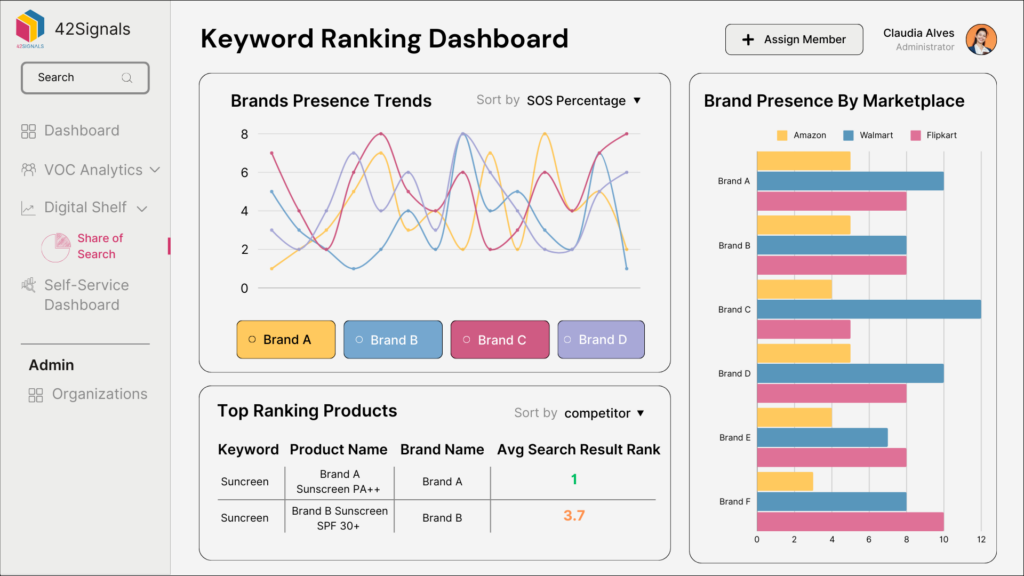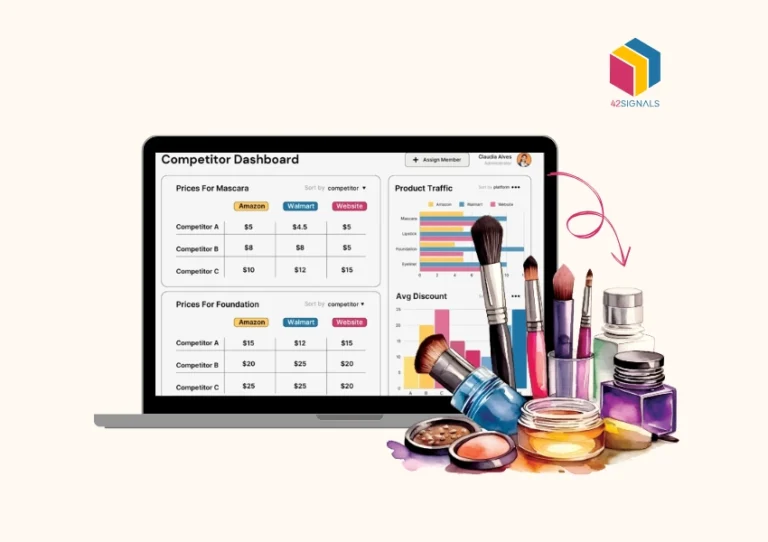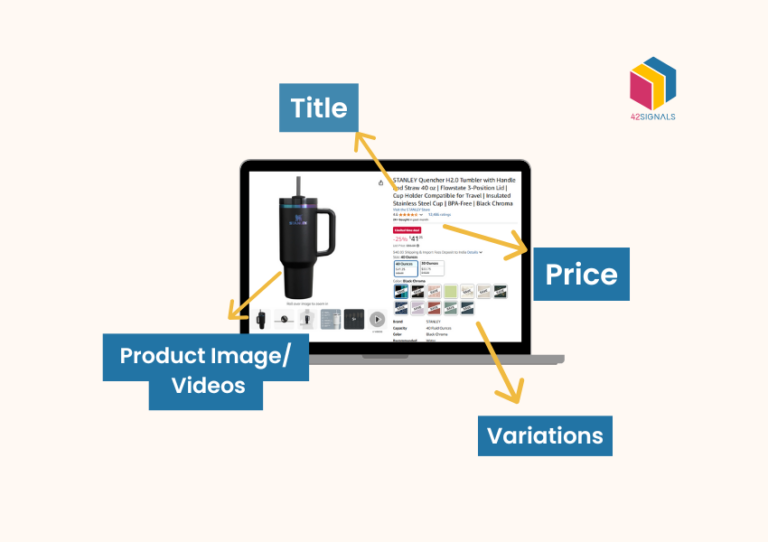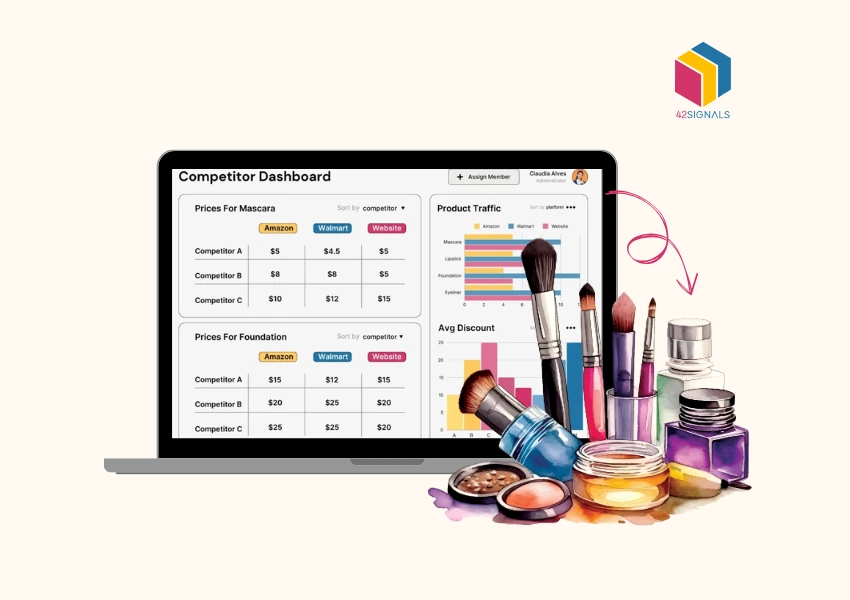A well-funded competitor launches a new quick commerce platform, outranking your online store overnight. Their products dominate search results, eating into your revenue. Meanwhile, your keyword strategy remains static—outdated and ineffective. Before you know it, their share of search grows while yours plummets. If this sounds familiar, you need to rethink your approach to keyword competitor analysis.
ECommerce and quick commerce are evolving faster than ever. A simple keyword research system will not cut it anymore.
Let’s look at what works in 2025.
What Is Keyword Competitor Analysis?

Keyword competitor analysis involves tracking, analyzing, and leveraging competitor search strategies to outperform them in organic and paid search rankings. It goes beyond basic keyword research by identifying gaps, opportunities, and high-performing keywords that drive revenue.
For instance, using a competitor keyword analysis tool, you might discover that your top rival ranks #1 for “same-day grocery delivery,” while your brand is barely in the top 20. This insight allows you to optimize your content, tweak your PPC campaigns, and refine product descriptions to compete effectively.
Why Competitor Keyword Analysis Is Non-Negotiable in 2025?
1. Gain Market Share with Share of Search Insights
Your brand’s share of search is a powerful indicator of consumer demand. If competitors are capturing a larger share of search volume for high-intent keywords, they’re also likely gaining more customers.
Example: A quick commerce startup noticed that its competitors dominated searches for “instant grocery delivery.” By analyzing their competitors’ keyword strategies and optimizing for long-tail keywords like “30-minute grocery delivery,” they increased their organic traffic by 40% in three months.
2. Identify Hidden Keyword Opportunities

By analyzing competitor keyword data, you can uncover untapped keyword suggestions that your audience is already searching for.
Pro Tip: Use a competitor analysis dashboard to track keywords competitors are ranking for but you aren’t. Tools like Semrush and Ahrefs allow you to compare domain rankings and identify new keyword opportunities.
3. Outperform Rivals with Real-Time Keyword Tracking
Search rankings fluctuate daily. If you’re not monitoring them in real time, you risk falling behind.
Example: An eCommerce fashion brand used a keyword ranking dashboard to track competitor movements. When a competitor started ranking higher for “summer linen dresses,” they immediately optimized their product pages with the same keyword and regained their position within weeks.
Step-by-Step Guide to Implementing Keyword Competitor Analysis

Step 1: Gather Competitor Keyword Data
Use advanced competitor keyword analysis tools like:
- 42Signals: Understand missing keywords, category keywords, and keyword suggestions.
- Semrush: Uncover competitors’ top keywords, backlinks, and traffic sources.
- Ahrefs: Analyze domain keyword rankings and track new/emerging competitors.
- Google Search Console: Identify which keywords drive the most traffic to your site.
Step 2: Analyze Share of Search Metrics
Your brand’s share of search measures how often your brand appears in search results compared to competitors.
- Identify keywords where competitors are gaining ground.
- Track branded vs. non-branded search traffic to adjust your strategy accordingly.
Step 3: Discover Keyword Gaps and Opportunities
Using your competitor analysis dashboard, pinpoint:
- Keywords competitors rank for but you don’t (high-priority optimizations).
- Keywords where you rank lower than competitors (improve content and backlink strategy).
- Emerging keyword trends in your industry (capitalize on new search opportunities).
Step 4: Optimize Content and Product Listings
Once you have identified high-value keywords, optimize your site accordingly:
- Update product descriptions with competitive keywords.
- Adjust metadata (titles, alt tags, descriptions) to include top-ranking search terms.
- Use keyword suggestion tools to discover variations and long-tail phrases.
Step 5: Monitor Performance and Adjust Strategies
SEO is an ongoing process. Use a keyword ranking dashboard to:
- Track keyword performance over time.
- Measure the impact of content updates.
- Adjust strategy based on real-time competitor movements.
Future of Keyword Competitor Analysis in ECommerce & Quick Commerce
1. AI-Powered Voice Search Optimization
With the rise of voice of customer analytics, brands must optimize for conversational and long-tail keywords. Expect voice search queries like “Where can I get groceries delivered in 30 minutes?” to become more dominant.
2. Hyper-Personalized Search Intent Strategies

Image Source: Neil Patel
Google’s algorithms increasingly prioritize user intent over generic keyword matching. Brands must shift towards search intent optimization rather than keyword stuffing.
3. Predictive Search Analysis
Using AI and machine learning, predictive search analysis will allow brands to anticipate keyword trends before competitors even realize they exist.
Best Tools to Supercharge Your Competitor Keyword Analysis

- 42Signals: An all-in-one competitor analysis dashboard for online marketplaces like Amazon, Walmart, etc.
- Semrush: Competitor keyword analysis, domain comparison, and backlink tracking.
- Ahrefs: Organic search insights, keyword gap analysis, and competitive rankings.
- Google Trends: Monitor search trend fluctuations and seasonality.
- SERanking: All-in-one SEO suite with competitive tracking features.
Conclusion
Keyword competitor analysis isn’t just about spying on competitors—it’s about using data to make smarter strategic decisions.
By using competitor keyword analysis tools, tracking your share of search, and using a keyword ranking dashboard, you can build a resilient SEO strategy that adapts to ever-changing eCommerce and quick commerce landscapes.
Ignoring keyword competitor analysis in 2025 means leaving revenue on the table for your competitors to claim. Stay ahead by continuously refining your approach and leveraging real-time insights.
Ready to Take Action?

Start optimizing your eCommerce or quick commerce store today with advanced competitor keyword analysis strategies, and watch your search rankings soar.Contact us today for a personalized demo.







